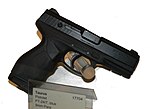Paraguayan Army
| Paraguayan Army | |
|---|---|
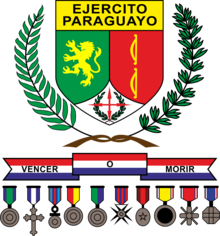 Paraguayan Army Seal | |
| Founded | Officially since 1811 |
| Country | |
| Type | Army |
| Size | 20,000 active personnel[1] 160,000 reserves |
| Part of | Armed Forces of Paraguay |
| Motto(s) | Spanish: Vencer o Morir To win or to die |
| March | Marcha al Mariscal Lopez |
| Anniversaries | 24 of July (Mariscal Lopez Birthday) |
| Engagements | Platine War War of the Triple Alliance Paraguayan Civil War (1911–1912) Paraguayan Civil War (1922-1923) Chaco War Paraguayan Civil War (1947) 1954 Paraguayan coup d'état 1989 Paraguayan coup d'état Paraguayan People's Army insurgency |
| Commanders | |
| Chief of the Paraguayan Army | General Darío Martin Cáceres Snead |
| Notable commanders | José Félix Estigarribia Francisco Solano López |
The Paraguayan Army (Spanish: Ejército Paraguayo) is the ground force branch of the Armed Forces of Paraguay. It is organized into three corps and nine divisions, and several commands and direction. It has gone to war on many occasions, notably in the War of the Triple Alliance (1864–1870) against Brazil, Argentina and Uruguay; the Chaco War against Bolivia; and the ongoing Paraguayan People's Army insurgency.
Mission
[edit]- Maintaining the sanctity of the land borders of the Republic of Paraguay.
- To strengthen civil-military relations.
- Cooperate in emergency rescue and relief operations during disasters.
- Organize, compose and manage reservations.
- To organize, equip and train strength to face any domestic or international threat/
- Cooperate in activities to support the country's national development.
- To cooperate with scientific and technological development of the country.
History
[edit]This section needs expansion. You can help by adding to it. (October 2024) |


Paraguay's army was formally established in 1811, the year of the country's independence. For the first several years of Paraguay's existence the commanders of the army, such as Fulgencio Yegros and Pedro Juan Caballero, formed the majority of the cabinet until 1814, when they were replaced by Dr. José Gaspar Rodríguez de Francia, who installed himself as supreme dictator for life after a series of political clashes with Yegros. Francia removed all army personnel from the government and reformed the army, which was by now inept and corrupt. He limited the power of the army by declaring that no rank above captain could be achieved, and that after three years of service officers were to be retired. By 1816 there were no officers in the army who had fought at the Tacuarí or the Paraguarí. Francia's horse-grenadier guard company was the first new unit created and was to form the nucleus of the army. Each captain was given command of a branch of the service, which consisted of line infantry, light infantry, dragoons, chasseurs, hussars and artillery. The infantry, artillery and hussars were stationed in the capital Asunción, and the rest of the army was stationed in outposts around the country to defend from attacks by Indians. The cavalry would go dismounted during peacetime, and were distinguished by the yellow aiguillette sewn onto their left shoulder. Although no formal wars were fought, conflicts with the Chaco Indians, particularly the sub-groups of the Guaykuru tribes, raged in the borderlands. The size of the army varied according to the magnitude of threat. In 1825 it was 5,000 strong, but in 1834 it was only 649 strong. There was also a large number of militia troops, which usually numbered around 25,000.
After Francia's death in 1840, Carlos Antonio López assumed power and modernized the army and expanded the navy. He opened an iron foundry at Ybycuí that produced arms and bullets and also built up a railway system in the country to transport troops and materiel.
Following the succession of Lopez's son, Francisco Solano López, the army was expanded yet further until it was one of the largest in South America, consisting by 1864 of 44 infantry battalions, 46 cavalry regiments and four artillery regiments. In that same year Paraguay fought its first actual war against Brazil, Uruguay and Argentina. Despite Paraguayan numerical superiority and initial success, the allies soon upped their game and Paraguay eventually found itself surrounded. Despite constant defeat on the field by the allies, the Paraguayans did not capitulate until Lopez had been killed in 1870, in the Battle of Cerro Corá, having been on the run with his 200 remaining men.
Presence in UN Missions
[edit]- Haiti (MINUSTAH)
- Cyprus (UNIFICYP) (a section-size group attached to the Argentinean Battalion)
- Democratic Republic of the Congo (MONUC)
- Chad Central African Republic (MINURCAT)
- Ivory Coast (ONUCI)
Structure
[edit]As of 2016, the Paraguayan Army had a total strength of 10,600 personnel, including 2,500 conscripts.[1]
The Paraguayan Army is composed of Presidential Guard Regiment, organized into a regimental HQ, two battalions (infantry and military police), an armored squadron and a battery of field artillery (plus the Mounted Ceremonial Squadron "Aca Caraya"). The regimental equipment includes three Argentine modified M4 Sherman tanks, four EE-9 armored cars, four EE-11 armored personnel carriers (APCs), three M9 halftracks mounting 20mm guns and four M-101 105 mm howitzers. Arguably, this "flagship" unit is structurally and physically the strongest of the whole of the Army. The REP is independent from other commands. The EP features two field artillery groups (GAC 1–12 88 mm QF-25 and GAC 2–12 105mm M-101) and one air defense artillery group (GAA 13 40 mm L 40/60, Oerlikon 20 mm cannons, and six M-55 4×12, 7.0 mm).
Six battalions of combat engineers, one communications battalion, one Special Forces battalion, seven regiments of infantry and six regiments of cavalry comprise the rest of the force. There is little organic aviation available to it.
Each corps has a weapons school run by its command. The logistical command manages and addresses materials, mobilization, health care, etc. The command of the Army Institute of Education administers three schools, commissioned and noncommissoned officers, a military academy and the CIMEFOR (a center for pre-military study that trains Reserve officers).
Each of the nine divisions that make up the three corps has one or two regiments of infantry or cavalry, its platoon of engineers, its communications section, military police units, etc.
- Presidential Guard Regiment with its base in Asunción
- 1st Army Corps (Curuguaty)
- Infantry Division 3
- Infantry Division 4
- Cavalry Division 3
- 2nd Army Corps (San Juan Bautista)
- Infantry Division 1
- Infantry Division 2
- Cavalry Division 2
- 3rd Army Corps (Mariscal Estigarribia)
- Infantry Division 5
- Infantry Division 6
- Cavalry Division 1
- Special forces command (Cerrito)
- One Special Forces battalion and one Special Forces school.
- Army Artillery command (Paraguari)
- Two artillery groups and one anti-aircraft group, one artillery school.
- The Infantry School and the Infantry Training Battalion.
- Army Command of engineers (Tacumbu)
- One school and six battalions.
- Army communications command(Tacumbu)
- One school and one signal battalion.
- Army Training and Doctrine Command
- Operates the Francisco López Military Academy, three military schools, and a noncommissoned officers school
- Army logistic command (Asunción)
- The logistic command manages and addresses materials, mobilization, health care, etc.
Equipment
[edit]Armored vehicles
[edit]| Name | Image | Type | Origin | Quantity | Status | Notes |
|---|---|---|---|---|---|---|
| M3 Stuart | 
|
Light tank | 10[2] | 10 operational as of 2014, 4 more in storage[2] | ||
| M2 half-track | 
|
Half-track Artillery tractor |
8[3] | |||
| M3 half-track | 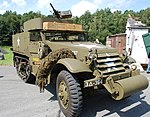
|
Half-track Armored personnel carrier |
23[3] | |||
| M8 Greyhound | 
|
Armored car | 12[4] | |||
| EE-9 Cascavel | 
|
Armored Car | 28[3] | Upgraded in Brazil in 2008. | ||
| EE-11 Urutu | 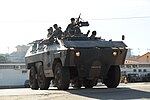
|
Armored personnel carrier | 12[3] |
Utility vehicles
[edit]| Land Rover Defender | 
|
Utility vehicle | 90 | 110 and 130 | |
| Ford Ranger | 
|
Utility vehicle | 19 | ||
| Agrale Marruá[5] | 
|
Utility vehicle | 17 | ||
| Chevrolet S-10 | 
|
Utility vehicle | 104 | ||
| M151[6] | 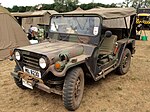
|
Utility vehicle | |||
| ARGO 8×8 | 
|
Amphibious all-terrain vehicle | 12 | ||
| Mitsubishi L200 | 
|
Utility vehicle | +11 | ||
| Trucks | |||||
|---|---|---|---|---|---|
| Mercedes-Benz Unimog | 
|
4x4 truck | |||
| Mercedes-Benz Atego | 
|
4x4 truck | |||
| Mercedes-Benz 1414/51 | 4x4 truck | ||||
| MAN KAT1 | 
|
4x4 truck | 20 | Ordered in 2013 | |
| Ford Cargo 17-22 | 
|
6x6 truck | 78+ | ||
| M54 | 
|
6x6 truck | |||
Artillery
[edit]| Name | Image | Type | Origin | Quantity | Status | Notes |
|---|---|---|---|---|---|---|
| Field artillery | ||||||
| M101 | 
|
105 mm howitzer | 20/26 | |||
| M30 mortar[7] | 
|
107 mm mortar | 8 | |||
Air defence systems
[edit]| Name | Image | Type | Origin | Quantity | Status | Notes |
|---|---|---|---|---|---|---|
| Oerlikon GAI-BO1 | 
|
Autocannon | 3 | 20mm autocannon | ||
| Bofors L/60[8] | 
|
Autocannon | 13 | 40mm autocannon |
Anti-tank weapons
[edit]| Name | Image | Type | Origin | Caliber | Notes |
|---|---|---|---|---|---|
| M72A7 LAW | 
|
Rocket-propelled grenade launcher | 66mm | 80 guns in service. | |
| M20 Super Bazooka | 
|
Rocket-propelled grenade | 88mm | 136 guns in service. | |
| M20[9] | 
|
Recoilless rifle | 105mm | 32 guns in service. |
Small arms
[edit]Ranks
[edit]It is important to note that the two most famous military leaders of Independent Paraguay, Francisco Solano López (during his own lifetime) and José Félix Estigarribia (after his death) were distinguished with the rank of Field Marshal of the Paraguayan Armies. However, this rank is just a "honorific distinction" for these two individuals who led the nation during the largest military conflicts Paraguay had to face, the Paraguayan War and the Chaco War.
Moreover, it is unknown if they ever had the garments of a Field Marshal. Solano López only received a "Marshal's Baton" but he kept wearing the uniform of a General of the Army while Estigarribia, apparently, never got nor received any type of Marshal's garments other than the honorific rank.
Officially, both Solano López and Estigarribia held the rank of General of the Armies of Paraguay.
- Commissioned officer ranks
The rank insignia of commissioned officers.
| Rank group | General / flag officers | Senior officers | Junior officers | |||||||||||||||||||||
|---|---|---|---|---|---|---|---|---|---|---|---|---|---|---|---|---|---|---|---|---|---|---|---|---|

|

|

|

|

|

|

|

|

|
||||||||||||||||
| General de ejército | General de división | General de brigada | Coronel | Teniente coronel | Mayor | Capitán | Teniente primero | Teniente | Subteniente | |||||||||||||||
- Other ranks
The rank insignia of non-commissioned officers and enlisted personnel.
| Rank group | Senior NCOs | Junior NCOs | Enlisted | |||||||||||||||||||||||||||||||||
|---|---|---|---|---|---|---|---|---|---|---|---|---|---|---|---|---|---|---|---|---|---|---|---|---|---|---|---|---|---|---|---|---|---|---|---|---|

|

|

|

|

|

|

|

|

|

| |||||||||||||||||||||||||||
| Sub-oficial principal | Sub-oficial mayor | Sub-oficial | Sargento ayudante | Sargento primero | Vice sargento primero | Sargento segundo | Cabo primero | Cabo segundo | Soldado | |||||||||||||||||||||||||||
See also
[edit]References
[edit]- Notes
- ^ a b IISS (2012), p. 398
- ^ a b de Cherisey, Erwan (29 December 2015). "Paraguay keeping M3 Stuart, M4 Sherman tanks in service". IHS Jane's Defence Weekly. Retrieved 2 January 2016.
- ^ a b c d IISS (2012), p. 399
- ^ "Trade Registers". Armstrade.sipri.org. Retrieved 2013-06-20.
- ^ "El Ejército del Paraguay presenta sus nuevos vehículos y ametralladoras".
- ^ "Annex C Appendix II". US Army Technical Manual of Foreign Military Sales: Battlefield Damage Assessment and Repair (PDF). Washington, D.C.: U.S. Army. 18 December 1987. p. 262. TM 9-2320-356-BD. Archived (PDF) from the original on 4 September 2012. Retrieved 15 June 2013.
- ^ Gander, Terry J. (22 November 2000). "National inventories, Paraguay". Jane's Infantry Weapons 2001-2002. p. 3240.
- ^ Military Balance 2016, p. 408.
- ^ Gander, Terry J.; Cutshaw, Charles Q., eds. (2001). Jane's Infantry Weapons 2001/2002 (27th ed.). Coulsdon: Jane's Information Group. ISBN 9780710623171.
- ^ a b c d e f g h i j k l m n "wiw_sa_paraguay - worldinventory". 2016-11-24. Archived from the original on 2016-11-24. Retrieved 2023-03-07.
- ^ a b c d e f g h i j k l m Jones, Richard D. Jane's Infantry Weapons 2009/2010. Jane's Information Group; 35 edition (January 27, 2009). ISBN 978-0-7106-2869-5.
- ^ Gander, Terry J.; Hogg, Ian V. Jane's Infantry Weapons 1995/1996. Jane's Information Group; 21 edition (May 1995). ISBN 978-0-7106-1241-0.
- ^ Ball 2011, p. 278.
- ^ World Armies (30 December 2009). "Paraguayan Police Special Forces". flicker.com. Retrieved 6 April 2017.
- ^ "Paraguay Army Chooses IWI's "Negev"". Israel Defense. 1 August 2015.
- ^ a b Cooke, Melinda W. (1990). "Chapter 5: National Security". In Hanratty, Dennis M.; Meditz, Sandra W. (eds.). Paraguay: A Country Study. Area Handbook Series (2nd ed.). Library of Congress. pp. 216–217. LCCN 89600299. Retrieved 5 October 2021.
Works cited
[edit]- Ball, Robert W. D. (2011). Mauser Military Rifles of the World. Iola: Gun Digest Books. ISBN 9781440228926.
- International Institute for Strategic Studies (IISS) (2012). "The Military Balance 2012". The Military Balance: Annual Estimates of the Nature and Size of the Military Forces of the Principal Powers. London: IISS. ISSN 0459-7222.
- International Institute for Strategic Studies (February 2016). The Military Balance 2016. Vol. 116. Routlegde. ISBN 978-1-85743-835-2.



